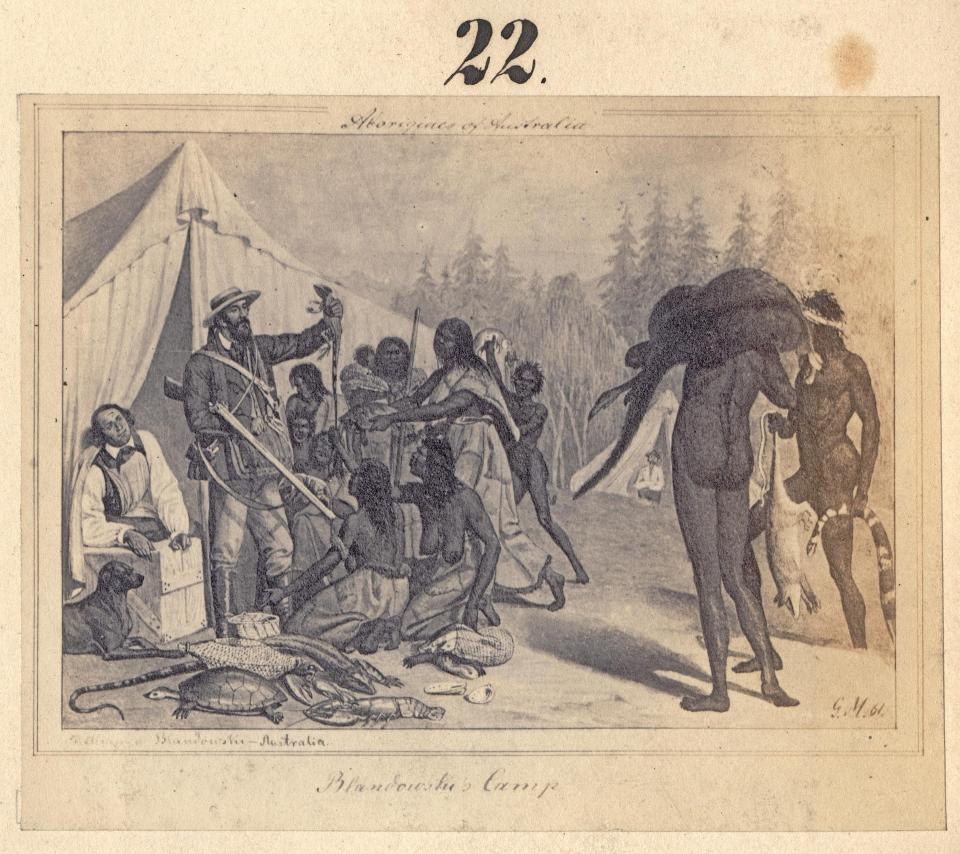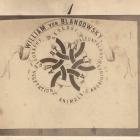The encyclopaedia compiled by the explorer Wilhelm von Blandowski (1822–1878) has an exceptional focus on local Aboriginal collection practices in Australia. While other expeditions in the nineteenth-century British Empire were ostensibly interested in geology, geography, zoology, and botany, Blandowski’s encyclopaedia of Australia from 1862 represents the changing natural and cultural environment of his Aboriginal “friends.”

Plate 1, Title and Contents of Blandowski’s 10 years’ experience in Australia (1862)
Plate 1, Title and Contents of Blandowski’s 10 years’ experience in Australia (1862)
All rights reserved. Created by Courtesy of Haddon Library, Faculty of Archaeology and Anthropology, University of Cambridge
Wilhelm von Blandowski, Plate 1, Title and Contents of Blandowski’s 10 years’ experience in Australia, Australien in 142 Photographischen Abbildungen, 1862.
This work is used by permission of the copyright holder.
Blandowski established the first museum for natural history in Melbourne and was employed by the Queen of England as the first government zoologist in the colony of Victoria. Over ten years (1849–1859) Blandowski compiled images and theories about the environment in the Pacific. His oeuvre during this time is deeply indebted to the artists Andrew Bartholomew, Ludwig Becker, Gerhard Krefft, Gustav Mützel, Fredrick Schoenfeld, James, George, and William Redaway, and others as yet unidentified
The hundreds of illustrations he commissioned represent the Indigenous guides and informants that were commonly used in scientific explorations to obtain specimens and provide identifications and details of habitat. Indigenous environmental knowledge and cultural classifications (names, relationships, cosmologies) thereby found expression in the field records of the natural philosophers and the artists with whom they worked.

Plate 22, Blandowski’s camp (1862)
Plate 22, Blandowski’s camp (1862)
All rights reserved. Created by Courtesy of Haddon Library, Faculty of Archaeology and Anthropology, University of Cambridge
Wilhelm von Blandowski, Plate 22, Blandowski’s camp (1862), Australien in 142 Photographischen Abbildungen, 1862.
This work is used by permission of the copyright holder.
The Blandowski collections embody systems of local knowledge, yet remained excluded from dominant systems of classification when the information returned to European metropolitan centers. Blandowski’s own career arguably fell into obscurity and failed precisely because he tried to foreground Aboriginal classification. The hundreds of field drawings from Australia made by the artists he employed represent a cross section of Aboriginal life and ecology that is not recorded in any other archive and is partially extinct in the natural world. The material he collected is furthermore significant because it presents the demand for an expansion of classification systems used to organize colonial collections in such a way that issues of race, gender, class, discipline (art/science), and geography (Australia/Europe) are no longer premises for exclusion from the history of science.
How to cite
von Zinnenburg Carroll, Khadija. “What Would Indigenous Taxonomy Look Like? The Case of Blandowski’s Australia.” Environment & Society Portal, Arcadia (2014), no. 12. Rachel Carson Center for Environment and Society. https://doi.org/10.5282/rcc/6292.
ISSN 2199-3408
Environment & Society Portal, Arcadia
 This work is licensed under a Creative Commons Attribution-NonCommercial-ShareAlike 4.0 International License.
This work is licensed under a Creative Commons Attribution-NonCommercial-ShareAlike 4.0 International License.
2014 Khadija von Zinnenburg Carroll
This refers only to the text and does not include any image rights.
Please click on the images to view their individual rights status.
- Allen, Harry, ed. Australia: William Blandowski’s Illustrated Encyclopaedia of Aboriginal Australia, Canberra, ACT: Aboriginal Studies Press, 2010.
- Blandowski, William. "Personal Observations Made in an Excursion towards the Central Parts of Victoria, including Mount Macedon, McIvor, and the Black Ranges." In Transactions of the Philosophical Society of Victoria, including the Papers and Proceedings of the Society, for the Past Year, ending in July 1 (1855): 50–74.
- Blandowski, William. "The Primary Upheaval of the Land around Melbourne and the Recent Origin of the Gypsum or Sulphate of Lime." In Personal Observations in Victoria. Melbourne, VIC: Goodhugh & Trembath, 1855.
- Blandowski, William. "Recent Discoveries in Natural History on the Lower Murray." In Transactions of the Philosophical Institute of Victoria, from September to December, 1857, inclusive 2/2 (1858): 124–37.
- Blandowski, William. "Ueber die Ureinwohner Australiens." In Sitzungs-Berichte der naturwissenschaftlichen Gesellschaft Isis zu Dresden 10–12 (1861): 101–10.








